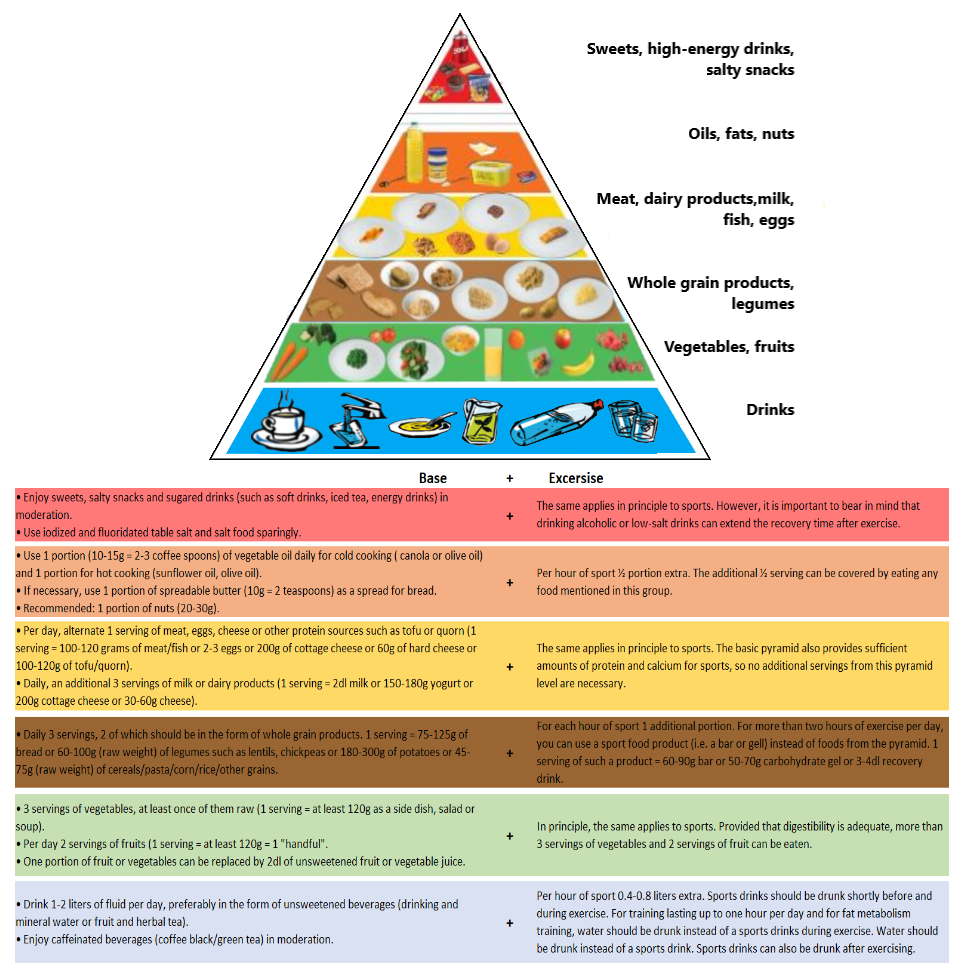Most people are familiar with the basic rules of a healthy diet. However many people only partially follow these rules daily. Here are the most important points.
As unprocessed as possible, fresh and planned
In everyday life, the same guidelines apply to athletes regarding healthy eating as to all people. It is not complicated, you just have to do it.
- Use as many unprocessed staple foods as possible, such as (non-hydrogenated) oils, nuts, berries, vegetables, lettuce, seasonal fruits, whole grains, etc.
- In addition, use many fresh ingredients such as herbs and garlic.
- Pasta, bread, rice, legumes are all in the diet as well – albeit in moderation.
- Animal products such as meat/fish and dairy products should be consumed in moderation and attention should be paid to their origin.
- Avoid prepared meals and sauces with many chemical additives (colorings, flavor enhancers, preservatives, etc.) as much as possible. Tip: A maximum of seven ingredients on the ingredient list of the packaging selects a “healthy” choice quite well.
- For beverages, give preference to water or unsweetened tea; consume sweetened beverages only in moderation.
- Reserve fixed time slots in the daily schedule for regular main meals – including breakfast.
- Eat according to your hunger, preferably sitting down.
- Ensure sufficient protein per main meal and adjust the amount of carbohydrates to the amount of physical activity.
The whole spectrum
Our stomach has no eyes. It can’t see whether we are the proud owners of a six-pack or whether we have a few extra kilos hanging over our hips. Our body’s daily basic needs are quite simple, regardless of our activity level. Our bodies want to be supplied with the necessary energy to be able to function. Nutrition should be versatile, healthy and balanced, preferably a little of everything and not too much of anything.
But it’s apparently not that simple: nutrition is a huge topic on everywhere. It is in magazines, books, cooking shows, online portals or native advertising messages. We are bombarded by advice on what we should eat, what is healthy, what is sustainable, what is bad for weight, good for the mind, positive for the immune system and conducive to athletic performance. Despite how adamantly many people present their solution, it is often difficult to prove causation. There are many variables when it comes to health and nutrition. Accordingly, recommendations for what constitutes a healthy and easily practicable diet are constantly changing. New scientific findings are constantly adjusting the advice.
How much – and what?
Let’s start with the basics and basic needs: Since virtually all food is available to us in the Western world and we do not have to ask ourselves whether we have enough to eat, as is the case elsewhere, the most important two points in our everyday diet are:
- What should I eat? – what should the composition of my food be, so that I can be as healthy as possible and perform as well as possible?
- How much should I eat? – How much can and should we eat so that our body weight is within a healthy range and remains as stable as possible long term?
In principle, you can achieve a stable body weight with two strategies. Either you keep your cravings under control. You control the amount of calories in your diet and thus your weight, regardless of whether you exercise a lot or a little. Or, far more practical: you increase your energy consumption as much as possible with regular exercise and can thus allow yourself some culinary variety that would otherwise quickly show up on the scales. Exercise increases energy consumption considerably. Compared to sitting, the multiplication factor per hour varies from 4 (moderate exercise) to 12 (very strenuous activity), and in elite sports it can even rise to a factor of 20.
The most competitive endurance athletes can burn an incredible amount of energy with daily training. Sometimes energy consumption can be so high that you can not replace all the calories consumed. It can come to the point where athletes always lose weight.
Special pyramid for athletes
Amateur athletes, however, can only dream of such “worries”, because even active people usually cannot indiscriminately eat everything without gaining weight. A well-balanced diet is therefore important. For active people, exercise at least provides the appealing motivation that the more you move, the more you can indulge in culinary delights.
The athletes’ pyramid is based on the “normal” nutrition pyramid propagated by the Swiss Society for Nutrition (SGE). This illustrates a balanced diet. You need larger quantities of foods lower on the pyramid. Once you get to the upper levels of the pyramid, you need to consume smaller quantities. There are no “forbidden” foods, everything is allowed and everything – with moderation – is sensible.

A balanced diet is characterized by the appropriate combination of foods in the right proportions. The general nutrition pyramid calculates that people move 30 minutes daily. This is not a given in society today. For this reason, efforts are underway to adapt the pyramid to the latest scientific findings. Especially the carbohydrate content is rather high for people who are not very active.
The food pyramid for athletes is intended for active people who do about 5 hours of exercise a week at a medium intensity. In the athlete’s pyramid, the right part of the chart is dedicated to additional exercise. It shows the additional food you can eat because of your increased energy usage.
do not read the quantities as absolute and binding. The basic message is: the more you exercise, the more you have to eat. Quantity is the difference, because qualitatively the diet in athletes hardly differs from a healthy diet of a normal adult. Energy consumption is the main difference. The differences between a non-athlete, an ambitious hobby athlete doing 10 hours of training and a competitive athlete doing 25-30 hours of training per week are enormous and must be compensated for individually.
How athletic are you?
Therefore, the first question in personal classification is: How athletic are you? Or to put it another way: what counts as sport, who counts as an athlete?
Both everyday movement and the understanding of sport among the population have changed massively in recent years. Normal everyday life has once again become much more sedentary than before the turn of the millennium due to digitization and the infrastructure of public transport. At the same time, many more people do sports today than 20 years ago. On the one hand, this is probably to counteract the aforementioned immobility in everyday life, but on the other hand it is also because the understanding of sport has changed. In the past, people mainly used systematic training to describe sport. Leisure activities such as hiking or dancing were not. Today, hiking is the booming, and many other leisure activities – even those with low energy expenditure – are considered sports.
Often too optimistic
The change in terminology harbors a certain potential danger with regard to nutritional behavior. If an office worker does an hour of exercise three times a week, he will probably describe himself as an athletic, active person. This is true even if he lives an otherwise sedentary everyday life. However, with his movement behavior he should ignore the athletes food pyramid. It is appropriate to base his nutrition on the normal nutrition pyramid. Many people consider themselves to be athletic or very athletic. In reality – added up over seven days – additional energy consumption through exercise for most people does not allow too much bonus calories and treats.
Here’s a little calculation. If you burn around 700 calories in one hour of exercise – which requires a lot of effort – you will consume an additional 2100 calories in three workouts a week. Divided by the number of days in the week, that’s 300 kilocalories per day that you’ve burned through exercise – in our example, just one medium-sized yogurt.
The food pyramid is a good guide not only for the right amount of food, but also for a healthy mix, so that there is no nutritional deficiency anywhere. Theoretically, you could maintain your weight with one bar of chocolate a day if you hardly eat anything else. But it is obvious that this is not very smart and important nutrients would be missing.
If you stick to the distribution of food according to the food pyramid, you will ensure you have a sufficient amount of energy. You also ensure a healthy distribution of the individual nutrients. This is especially important in the case of very weight-conscious people. They often avoid energy-rich and supposedly “bad” foods such as oils or nuts in order limit calories. The information in the pyramid also covers the daily requirements of micronutrients, such as vitamins, calcium, magnesium or iron.
Supplements yes or no?
Currently, health and in particular an effective immune system are of special importance in society’s consciousness. Accordingly, there are countless supplements on the market that are supposed to support the immune system.
For non-athletes and hobby athletes, however, the following applies:
Anyone who with a balanced diet not training like a competitive athlete does not need daily supplements. The exception being if they have any identified any specific nutritional deficiencies. Supplements are not part of the basic diet, but may be appropriate in specific situations (competition, hard training phases, training camps, regeneration). In general, athletes should distinguish between a healthy diet in everyday life and specific sports and competition situations. In competitions other nutritional needs and rules apply in the short term.
When it comes to health, the importance of a good balanced diet needs to be considered by everyone. This is true for non-athletes and athletes. In terms of performance, you need to put the whole issue in perspective. A poor diet can turn a potential champion into a mediocre athlete. But at the same time, an optimal diet does not turn a mediocre athlete into a champion.
This Blog Article was made available to us by Fit for Life. Fit for Life is the Swiss magazine for fitness, running and endurance sports. Would you like to read such articles regularly? Then Click here.

If you are looking for a nutrition plan that considers your individual nutritional needs with your training, check out the 2PEAK nutrition plan.
